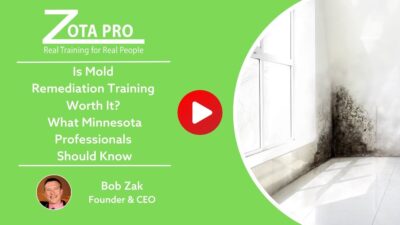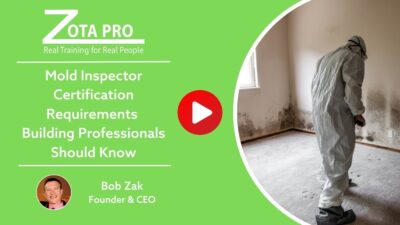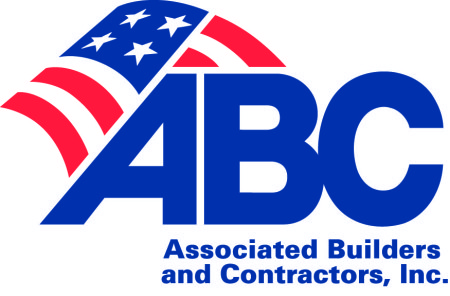ZOTA Professional training provides instant access to hundreds of top-rated professional development and certification courses through our nationwide network.
Course instructors are highly experienced professionals that connect classroom training to real world situations making it easy to apply the knowledge to your own work activity.
- Select courses convenient for you; choose in-person or online training options
- Never get charged hidden fees
- Get certified with confidence through our network of accredited courses
- Discover how we can meet your needs. See what our past clients are saying for yourself!
Lead Renovator Certification is required for Renovation, Repair, and Painting (RRP) work. This course is intended for all contractors and other organizations responsible for projects performed on pre-1978 residential properties or child-occupied facilities. ZOTA Professional Training offers many local courses coming up soon. Register today! Search all initial courses by location HERE. Course delivered in-person. Course delivered in-person. Course delivered online. Lead Renovator Certification is required for Renovation, Repair, and Painting (RRP) work. This course is intended for all contractors and professionals responsible for projects performed on any pre-1978 residential property or child-occupied facility. ZOTA Professional Training offers Real Training for Real People, with many local courses coming up soon. Get your Lead Paint Certification now. Register today! Search all initial courses by location HERE. Course delivered in Spanish. Affordable and convenient RRP EPA Lead Re-Certification. If it’s time to renew your EPA RRP Lead Certification ZOTA has you covered with onsite and classroom options. This refresher course will provide your Lead Certification for another 5 years. This Training will update you on how to best comply with the EPA Renovation, Repair and Painting Rule and the HUD Lead Safe Housing Rule. Search all refresher courses by location HERE. Course delivered in Spanish. Course delivered online.Featured Courses
Lead Renovator Certification Initial Course

Lead Renovator Certification In-Person Refresher Course

Affordable and convenient RRP EPA Lead Re-Certification. If it’s time to renew your EPA RRP Lead Certification ZOTA has you covered with onsite and classroom options. This in-person refresher course will extend your Lead Certification for another 5 years. This Training will update you on current best practices for the EPA Renovation, Repair and Painting Rule. Don’t delay. Renew with this option before you expire. Search all refresher courses by location HERE.Lead Renovator Initial Online Certification (Hybrid) Course
 All the benefits of the Lead Renovator Certification Initial in-person course with the option of doing most of the training anywhere at your pace. This option provides you an easy to follow interactive presentation which makes learning easy and enjoyable. You then come in for a short interactive hands-on training and gain your certification. It’s that easy! Great for idividuals who can’t afford to give up a whole day in the classroom. Learn more about Online Lead Certification Hybrid training. HERE.
All the benefits of the Lead Renovator Certification Initial in-person course with the option of doing most of the training anywhere at your pace. This option provides you an easy to follow interactive presentation which makes learning easy and enjoyable. You then come in for a short interactive hands-on training and gain your certification. It’s that easy! Great for idividuals who can’t afford to give up a whole day in the classroom. Learn more about Online Lead Certification Hybrid training. HERE.Lead Renovator Certification Initial Course (SPANISH)
Lead Renovator Certification Refresher Course (SPANISH)
Lead Certification Online Refresher Course
 The EPA Lead Certification Online Refresher Course is 100% online with no hands-on requirements. You can relax and take this EPA Lead Certification Online Refresher Course from the convenience of your own home. This course is intended as an option for you to renew your Initial EPA Lead Renovator Certification and it complies with the EPA’s Renovation, Repair, and Painting Rule, otherwise known as the RRP Rule. Register for the online course HERE.
The EPA Lead Certification Online Refresher Course is 100% online with no hands-on requirements. You can relax and take this EPA Lead Certification Online Refresher Course from the convenience of your own home. This course is intended as an option for you to renew your Initial EPA Lead Renovator Certification and it complies with the EPA’s Renovation, Repair, and Painting Rule, otherwise known as the RRP Rule. Register for the online course HERE.
Who we are
Your go-to source for OSHA, mold, asbestos, and EPA lead certification courses.
At ZOTA Professional Training, we assist contractors, inspectors, property managers, and safety professionals. We aim to enhance safety and ensure compliance with federal and state regulations. We offer courses on EPA lead renovation, asbestos abatement, mold remediation, and OSHA compliance training. Our expert-led training is available in person, online, or in hybrid formats.We strive to make certification quick, affordable, and easy to access. We offer flexible scheduling and bilingual options to meet different needs. If you need to renew your license or learn new skills, we will help you stay compliant, confident, and ready for any job.
Il Viagra è il trattamento più noto per gli uomini adulti che soffrono di disfunzione erettile. Le pillole di Viagra vengono utilizzate per trattare la disfunzione erettile da oltre due decenni e si sono dimostrate molto efficaci per oltre il 70% degli uomini. È possibile acquistare Viagra online presso una farmacia senza ricetta in Italia.
Getting certified in mold remediation is more than just another credential for contractors, restoration teams, and environmental service professionals. It’s a crucial step toward doing safer and more profitable work. Failure to adequately address mold issues can lead to delays […] Mold isn’t just an eyesore; it’s a significant health risk and poses a danger to the structural integrity of your building. For construction and restoration professionals, understanding mold inspection and remediation is essential to protecting both properties and people. Obtaining […] Modern construction and property management professionals are busier than ever. Between tight project schedules, compliance deadlines, and travel limitations, attending an in-person course isn’t always practical. That’s where Online Asbestos Training comes in, offering flexibility, accessibility, and the same OSHA-compliant […]Latest news
Is Mold Remediation Training Worth It? What Minnesota Professionals Should Know
Mold Inspector Certification Requirements Building Professionals Should Know
Benefits of Choosing Online Asbestos Training Over In-Person Classes
We understand how critical it is for professionals to have the proper credentials.
Skipping accredited training can result in fines. It also means missed job opportunities and safety risks for workers and clients. Our courses help you stay compliant and protected. We offer them in-person, online, and in flexible hybrid formats.
We make it easy for everyone to get the certifications they need.
The ZOTA Pro Process reduces the stress of compliance training. Our skilled instructors offer engaging, hands-on learning in person, online, or hybrid formats. We provide simple scheduling, low prices, and flexible courses.
Course was engaging and easy to follow along. Simple and practical application of hands-on learning was useful.
Overall it was clear and concise, helping me get what I need. I like the overall laid back style and atmosphere.
Bob was extremely knowledgeable and explained everything in great detail. He delivered the information with great confidence.
Hands on training with props were useful. Great.
I understand responsibilities of the EPA renovator and responsibilities as an owner. The instructor did very well, energizing and easy to understand…







